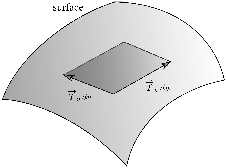I'll consider the problem of finding the area of part of a surface in
![]() :
:
![]()
Here is a heuristic motivation for the formula.
In our discussion of the tangent plane to a surface, we found a normal vector by taking two vectors in the tangent plane and taking their cross product. We considered a small piece of the surface near the point of tangency. A small piece will be nearly flat, and will look like the parallelogram depicted below (exaggerated so you can see it):

The sides of the parallelogram are determined by the tangent vectors
![]() and
and ![]() , scaled up the the parameter
increments
, scaled up the the parameter
increments ![]() and
and ![]() . The area of the parallelogram should be
the length of the cross product:
. The area of the parallelogram should be
the length of the cross product:
![]()
To get the area of the part of the surface corresponding to the region R in the u-v plane, integrate to add up the areas of the parallelograms:
![]()
As a special case, consider a surface ![]() given as the
graph of a function. A normal vector is given by
given as the
graph of a function. A normal vector is given by
![]()
Hence,
![]()
In this case, the area of the surface is
![]()
Example. Find the area of the part of the
surface ![]() which lies inside the cylinder
which lies inside the cylinder ![]() .
.
![]()
The region of integration is the interior of the circle ![]() :
:
![]()
I'll convert to polar. The region becomes
![]()
The integrand is
![]()
The area is
![]()
Example. Find the area of the surface
![]()
![]()

![]()
The area of the surface is
![]()
Example. (a) Find the area of the sphere ![]() by representing the top hemisphere as the
graph of a function.
by representing the top hemisphere as the
graph of a function.
(b) Find the area of the sphere ![]() using the parametrization
using the parametrization
![]()
(a) The top hemisphere is
![]()
Thus,
![]()
![]()
The region of integration is the interior of the circle ![]() :
:
![]()
I'll convert to polar. The region is
![]()
Likewise,
![]()
I need to double the area for the top hemisphere to get the area of the whole sphere:
![]()
(b)
![]()

![]()
The area is
![]()
Copyright 2018 by Bruce Ikenaga